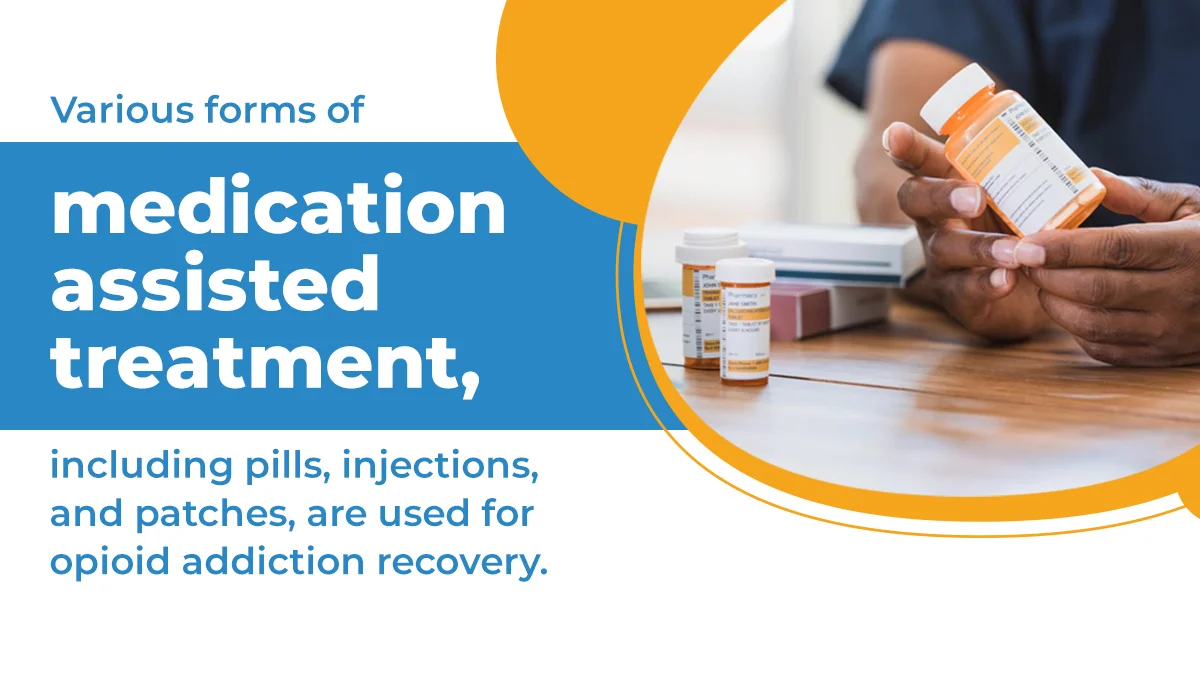
Effectiveness Of Medication-Assisted Treatment
Explore the effectiveness of medication-assisted treatment with The Recovery Team-Newton.

Medication-assisted treatment (MAT) is an inclusive approach to treating substance use disorders. It combines FDA-approved medicines with counseling and behavioral therapies to provide a holistic approach to healing.
MAT is effective in managing withdrawal symptoms and reducing cravings, helping individuals stay engaged in treatment and achieve long-term recovery.
MAT is effective in reducing illicit drug use, overdose deaths, and criminal activity. Here’s what you need to know:
The Recovery Team-Newton offers reliable recovery services if you or a loved one needs assistance. Call us at (501) 271-3342 for more information.
Medication-assisted treatment is a complete approach to treating substance use disorders. MAT is primarily used for opioid and alcohol use disorders but can also be effective for other substances. The medications help normalize brain chemistry, block the euphoric effects of alcohol and opioids, relieve desires, and normalize body functions without the negative impact of the abused drug.
MAT has been shown to improve patient persistence, increase retention in treatment, decrease illicit opiate use and other criminal actions, and increase patients’ ability to gain and maintain employment.
Medication-assisted treatment (MAT) is a prevailing tool in the fight against substance use disorders. By reducing withdrawal indications and cravings, these medications help people stay focused on their recovery journey. Whether dealing with opioids, alcohol, or tobacco, MAT offers hope and support for a healthier, sober life.
Opioid use disorder involves addiction to substances like heroin, prescription painkillers, and synthetic opioids. MAT for OUD includes methadone, buprenorphine, and naltrexone. These medications reduce withdrawal symptoms and cravings, helping individuals stay on track with their recovery.
Methadone is a long-acting opioid used to address OUD. It acts by binding to the same brain receptors as opioids, lessening withdrawal symptoms and cravings. Methadone is taken daily under medical supervision, making it a safe and effective option for many people.
Buprenorphine is another medication used for OUD. It partially activates opioid receptors, providing relief from cravings and withdrawal signs without producing the same high as other opioids. Buprenorphine can be prescribed by doctors and taken at home, offering more flexibility than methadone.
Naltrexone is a non-opioid medication that blocks opioid receptors. This prevents opioids from producing a high, making it easier for people to stay in recovery. Naltrexone can be taken as a daily pill or a monthly injection. It is effective for those who have already detoxed from opioids.
Alcohol use disorder involves problems with alcohol consumption, ranging from binge drinking to severe alcoholism. MAT for AUD includes disulfiram, acamprosate, and naltrexone. These medications help reduce cravings and the urge to drink.
Disulfiram works by causing unpleasant reactions when alcohol is consumed. These reactions include nausea, vomiting, and headaches. By creating a strong deterrent, disulfiram helps people avoid drinking alcohol. It is taken as a daily pill.
Acamprosate aids in restoring the balance of chemicals in the mind affected by long-term alcohol use. It reduces cravings and withdrawal symptoms, making it easier for people to maintain sobriety. Acamprosate is taken three times a day.
Naltrexone also helps with AUD by blocking the pleasurable effects of alcohol. This reduces the urge to drink and helps people stay sober. As for OUD, naltrexone for AUD can be taken as a daily pill or a monthly injection.
Tobacco use disorder involves addiction to nicotine, which is found in cigarettes and other tobacco products. MAT for tobacco use includes nicotine replacement therapy (NRT), varenicline, and bupropion. These treatments help people quit smoking by reducing withdrawal symptoms and cravings.
Nicotine replacement therapy provides a safer form of nicotine to help reduce withdrawal symptoms and cravings. NRT comes in various forms, such as patches, gum, lozenges, nasal spray, and inhalers. These products deliver controlled amounts of nicotine, allowing people to reduce their tobacco dependence gradually.
Varenicline helps people quit smoking by blocking the effects of nicotine in the brain. This reduces the pleasure associated with smoking and decreases cravings. Varenicline is taken as a daily pill, starting a week before the quit date and continuing for 12 weeks or more.
Bupropion is an antidepressant that also helps with smoking cessation. It works by affecting the brain chemicals involved in nicotine addiction, reducing cravings and withdrawal symptoms. Bupropion is taken as a daily pill, usually starting one to two weeks before the quit date.
Other substance use disorders include addictions to drugs like cocaine, methamphetamine, and cannabis. Currently, there are no FDA-approved medications specifically for treating these disorders. However, research is ongoing to find effective treatments.
Behavioral therapies and support groups play a crucial role in helping people recover from these addictions. In some cases, medications approved for other conditions may be used off-label to help manage withdrawal symptoms and cravings.
MAT combines FDA-approved medications with counseling and behavioral therapies to provide a comprehensive approach to recovery.
Comparative studies look at how different medications for addiction treatment (MAT) work. Researchers compare medicines like methadone, buprenorphine, and naltrexone. Methadone helps reduce cravings and withdrawal symptoms.
Buprenorphine also lessens cravings and can be taken at home. Naltrexone blocks the effects of opioids. Studies show that methadone and buprenorphine are effective for many people. Naltrexone works well for those who have already detoxed. These studies help doctors decide which medication might be best for each person.
Several factors influence how well MAT works. One important factor is the type of addiction. For opioid addiction, methadone and buprenorphine often work best. The patient’s health and history also matter. People with stable lives and support systems tend to do better with MAT.
Another factor is how the medication is given. Regular monitoring by healthcare providers improves success rates. Motivation and commitment to the treatment plan are crucial. Patients who actively participate in counseling and support groups usually see better results. These factors help determine the most effective MAT for each individual, ensuring better recovery outcomes.
Medication-assisted treatment (MAT) includes the use of medications, such as methadone, buprenorphine, and naltrexone, in combination with counseling and behavioral therapies for the treatment of opioid use disorder (OUD).
MAT is effective in reducing opioid use, preventing opioid overdose, and improving overall treatment outcomes. It is also used in the treatment of alcohol use disorder. MAT should be provided in a comprehensive treatment program tailored to the individual’s needs.
MAT for substance abuse typically involves several phases. The initial phase focuses on assessment and stabilization, evaluating the individual’s drug abuse history, overall health, and mental health status. This phase aims to stabilize the individual and address immediate medical or psychiatric issues. The next phase involves induction, where medications are introduced to help manage withdrawal symptoms and cravings.
The maintenance phase follows, where the goal of MAT is to prevent relapse and promote recovery. Throughout these phases, counseling and behavioral therapies are often integrated to address the psychological aspects of substance abuse and support long-term recovery.
The medication-assisted treatment (MAT) program combines higher doses of full opioid agonists, like Naloxone, with counseling and behavioral therapies to effectively treat opioid dependence. MAT has been clinically proven to be an effective treatment for opioid dependence and is also used for alcohol addiction.
It addresses medical conditions related to drug and alcohol abuse, as well as mental health disorders, providing comprehensive care for individuals struggling with addiction.
Our comprehensive services provide structured support tailored to your needs, ensuring you have a solid foundation for recovery. Our medication-assisted treatment program helps manage withdrawal symptoms and cravings, making the recovery process smoother and more effective.
Furthermore, our dedicated therapists offer personalized counseling to address underlying issues and build coping strategies for lasting healing.
Your journey to recovery is our top priority. Call (508) 978-2772 to let us help you build a healthier tomorrow.

Explore the effectiveness of medication-assisted treatment with The Recovery Team-Newton.

Explore the examples of dual diagnosis and its treatment plans for better outcomes with The Recovery Team-Newton.

Explore how long drug rehab programs are with the complete guide from The Recovery Team-Newton.